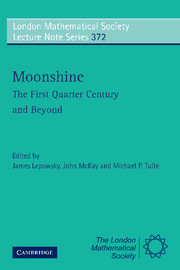 Moonshine - The First Quarter Century and Beyond
Moonshine - The First Quarter Century and Beyond Book contents
- Frontmatter
- Contents
- Preface
- Schedule of Talks
- Characters of Crossed Modules and Premodular Categories
- On the Injectivity of the Kudla-Millson Lift and Surjectivity of the Borcherds Lift
- Ordered Spanning Sets for Vertex Operator Algebras and their Modules
- Friendly Giant Meets Pointlike Instantons? On a New Conjecture by John McKay
- Modularity of Trace Functions in Orbifold Theory for ℤ-Graded Vertex Operator Superalgebras
- Twisted Modules for Vertex Operator Algebras
- Vertex Operators and Sporadic Groups
- The Algebraic Meaning of Being a Hauptmodul
- Borcherds' Proof of the Conway-Norton Conjecture
- On the Connection of Certain Lie Algebras with Vertex Algebras
- Vertex Operators and Arithmetic: How a Single Photon Illuminates Number Theory
- Rational Vertex Operator Algebras and their Orbifolds
- Quasi-finite Algebras Graded by Hamiltonian and Vertex Operator Algebras
- On Certain Automorphic Forms Associated to Rational Vertex Operator Algebras
- Moonshine and Group Cohomology
- Monstrous and Generalized Moonshine and Permutation Orbifolds
- New computations in the Monster
On the Injectivity of the Kudla-Millson Lift and Surjectivity of the Borcherds Lift
Published online by Cambridge University Press: 06 July 2010
- Frontmatter
- Contents
- Preface
- Schedule of Talks
- Characters of Crossed Modules and Premodular Categories
- On the Injectivity of the Kudla-Millson Lift and Surjectivity of the Borcherds Lift
- Ordered Spanning Sets for Vertex Operator Algebras and their Modules
- Friendly Giant Meets Pointlike Instantons? On a New Conjecture by John McKay
- Modularity of Trace Functions in Orbifold Theory for ℤ-Graded Vertex Operator Superalgebras
- Twisted Modules for Vertex Operator Algebras
- Vertex Operators and Sporadic Groups
- The Algebraic Meaning of Being a Hauptmodul
- Borcherds' Proof of the Conway-Norton Conjecture
- On the Connection of Certain Lie Algebras with Vertex Algebras
- Vertex Operators and Arithmetic: How a Single Photon Illuminates Number Theory
- Rational Vertex Operator Algebras and their Orbifolds
- Quasi-finite Algebras Graded by Hamiltonian and Vertex Operator Algebras
- On Certain Automorphic Forms Associated to Rational Vertex Operator Algebras
- Moonshine and Group Cohomology
- Monstrous and Generalized Moonshine and Permutation Orbifolds
- New computations in the Monster
Summary
Abstract
We consider the Kudla-Millson lift from elliptic modular forms of weight (p + q)/2 to closed q-forms on locally symmetric spaces corresponding to the orthogonal group O(p, q). We study the L2-norm of the lift following the Rallis inner product formula. We compute the contribution at the Archimedian place. For locally symmetric spaces associated to even unimodular lattices, we obtain an explicit formula for the L2-norm of the lift, which often implies that the lift is injective. For O(p, 2) we discuss how such injectivity results imply the surjectivity of the Borcherds lift.
Introduction
In previous work, we studied the Kudla-Millson theta lift (see e.g.) and Borcherds' singular theta lift (e.g.) and established a duality statement between these two lifts. Both of these lifts have played a significant role in the study of certain cycles in locally symmetric spaces and Shimura varieties of orthogonal type. In this paper, we study the injectivity of the Kudla-Millson theta lift, and revisit part of the material of from the viewpoint of, to obtain surjectivity results for the Borcherds lift. Moreover, we provide evidence for the following principle: The vanishing of the standard L-function of a cusp form of weight 1 + p/2 at s0 = p/2 corresponds to the existence of a certain “exceptional automorphic product” on O(p, 2) (see Theorem 1.8).
- Type
- Chapter
- Information
- Moonshine - The First Quarter Century and BeyondProceedings of a Workshop on the Moonshine Conjectures and Vertex Algebras, pp. 12 - 39Publisher: Cambridge University PressPrint publication year: 2010
- 4
- Cited by


